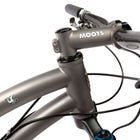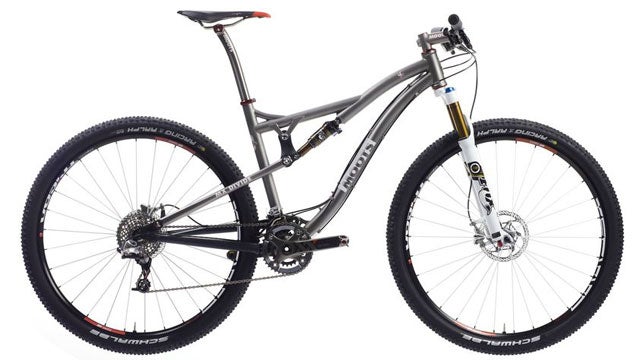Let’s start with a full disclosure. I am a big fan of Moots. I have friends at the Steamboat Springs, Colorado, company, and believe in their small-batch, high-quality mission. I also love titanium frames and, having ridden most major offerings out there, still feel that Moots puts out some of the most beautifully crafted ti bikes on the planet. My , which I purchased in 2007, is the one bike that has remained in the stable year-in and year-out.
The Cycle Life
Looking for a new ride? Check out Gulley’s most recent six-month tests on his favorite rides. A look at the aluminum chain stays
A look at the aluminum chain stays The bottom bracket
The bottom bracket The gorgeous carbon fiber rocker link
The gorgeous carbon fiber rocker link The titanium stem
The titanium stemIt’s hardly surprising, then, that the , Moots’ latest full-suspension entry, was probably one of the bikes I anticipated most last year. Though the company’s venerable YBB soft tail is the undisputed leader in its class, Moots has had mixed success in the full-suspension realm over the years. So I was eager to see if this 100-millimeter cross-country rig would better its predecessors’ reputations—and live up to my own high expectations.
The answers are yes and sort of, in that order. The MX Divide definitely makes Moots competitive in today’s crowded field of cross-country 29ers. And though it’s a mighty fine ride, I won’t be trading up my Mooto X just yet.
The Frame
Though Moots is excellent at manufacturing titanium bicycles, they realized that fabrication expertise does not necessarily equal engineering know-how. So for the MX Divide, the company teamed up with the Sotto Group, the same design house responsible for Yeti’s excellent platform.
The resulting single-pivot design, dubbed Fusion Link, is well thought out and a pleasure on the trail. The frame is all titanium except for aluminum chain stays for additional stiffness and a gorgeous carbon fiber rocker link. It’s built around a Fox RP23 Kashima coated shock, and other niceties include an oversize 44mm head tube, a PF30 bottom bracket, a large-gauge 30.9-millimeter seat tube for added rigidity, and a 142 x 12mm rear thru-axle. Nitty-gritty aside, the swoopy tubes and continuous lines from down tube through to seat stays give the MX Divide a classy, beautiful aesthetic befitting the Moots name.
On the trail, the bike feels like a classic cross-country machine. The suspension design is quite active, so testers found themselves switching frequently between climb, trail, and descend modes. In the firmest setting, the MX Divide was responsive without being jangly, partly because the smoothing quality of the titanium helped to soak up miserable little chatter.
Testers raved about how well the bike climbed, keeping good rear traction in the middle setting. The long (110mm) stem helped by keeping weight over the front end, but many testers were happier with the quicker steering and shorter cockpit when we subbed in an 80mm Thomson stem, even though that led to a bit more lift on steep climbs. Acceleration and pedaling responsiveness were just average, in part because of the longer chain stays and in part because the frame, at 6.5 pounds, isn’t exactly feathery. That’s probably our biggest niggle with the MX Divide: while it rides fairly well for a cross-country bike, it’s not exactly light enough to keep up with the speediest frames on the market.
Wide open, the bike was plush and active and hopped comfortably through shin-high rubble and down picnic-bench height stair steps. Again, the buttery titanium frame helped take the edge off, though the suspension definitely felt a little outgunned when the terrain got rowdy.
In the end, the MX Divide seemed to be most at home on singletrack that was swoopy but not too tight and trails that were lumpy but not overly steep or rough. It’s a stable, super-comfortable and predictable machine, but we couldn’t escape the sense that it was a master at no one particular thing.
The Components
Moots offers fully custom builds on the MX Divide, so it’s not worth dwelling too long on parts. The key exception is the house-built components, including the seat post and stem. Machining and finish on both parts was as clean and surgical as the rest of the company’s product, though as noted above many testers found the 110mm Open Trail Stem long and retro. When we subbed it with a shorter, burlier aluminum Thomson, we also realized that the titanium makes for a somewhat flexy stem, too. On the other hand, the was a big favorite. Saddles installed more easily than on almost any other model we’ve tried, and the independent tilt and fore/aft adjustment made it a snap to fine-tune. Seat posts are often fiddly and annoying, so it’s refreshing to see such an elegant design.
Our MX Divide was built with full SRAM XX parts. Shifting was snappy as ever, and for once we didn’t have any problem with these brakes. Moreover, given that the frame isn’t the lightest around, these superlight parts made sense here. You could save even more weight with a RockShox SID fork, though testers liked the robust feel of the Fox 32 Float 29.
The only real complaint was with the wheels, a set of DT Swiss X450 rims laced to DT 350 hubs. There was nothing wrong with the wheels, per se, but several testers commented that they were a little heavy and clunky for such a premium bike. Wheels make a massive difference in the way a 29er rides, and we felt it was a shame not to have something stiffer and lighter. When we installed our own Easton EC90 XC 29s, the bike felt instantly more lively and nimble and carved through rougher terrain with greater ease and steadiness.
The Verdict
The MX Divide left me conflicted. On one hand, it’s a stunning piece of design work that fills out the Moots’ mountain bike line well. Most testers liked riding it and oohed and aahed over the looks. The aesthetics and quality are second to none.
Titanium has a very particular and smooth ride sensation, and the material gives the MX Divide a sturdy yet forgiving feel that neither carbon nor aluminum can duplicate. Moreover, the Fusion Link suspension and carefully crafted geometry make for balanced and predictable handling suited to carving the trails and fire roads in and around Steamboat Springs and Colorado.
On the other hand, the MX Divide costs as nearly any bike on the market—$4,955 for the frame set; around $9,200 as tested—and yet it doesn’t stand out in terms of performance. At 26.1 pounds, our MX Divide weighed 12 to 25 percent more than comparably priced carbon racers, and though some of that is wheel weight, this bike is not going to be competitive as a flat-out race machine. Likewise, there are plusher and more capable 29ers in the 120mm category that weigh the same as the MX Divide and cost less. That’s not necessarily a commentary on the Moots; rather, it speaks to how competitive the field has become.
And while the MX Divide may not be the best in any one category, it stands out as a handcrafted, small-batch, made in America bike that can hold its own. There are faster, lighter, and plusher bikes out there. But none are as painstakingly created or beautifully accomplished as the MX Divide. This bike will never rule its realm as the YBB has lorded over the soft tail segment. But it still has a place among avid and capable riders who want something more distinctive than the other ten plastic bikes on a ride.


